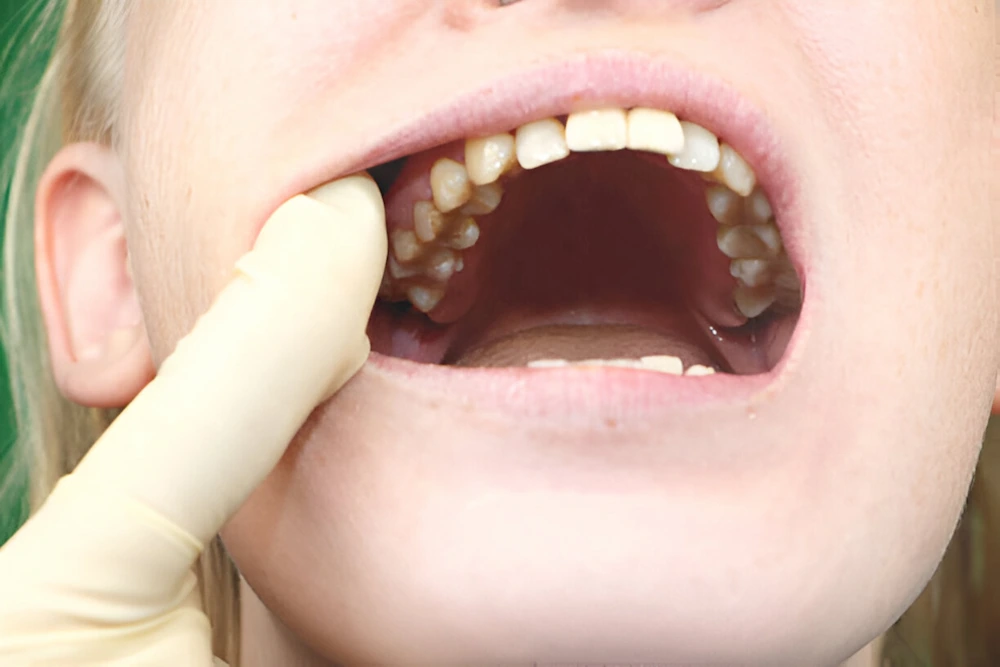A healthy mouth is crucial for overall well-being, but sometimes unexpected changes can occur. One such change is the appearance of a yellow roof of the mouth. This can be alarming and signal underlying issues, ranging from benign conditions to serious health problems. Explaining the causes can help determine the best course of action. This article will explore ten common causes of a yellow roof of mouth, providing insights into each condition and offering advice on when to seek professional help. By becoming informed, you can take proactive steps to maintain your oral health and overall well-being.

#1 Poor Oral Hygiene
Neglecting oral hygiene can lead to numerous problems, including a yellow roof of mouth. When the mouth isn’t cleaned regularly, bacteria can build up and cause discoloration. Brushing twice daily, flossing daily, and using an antiseptic mouthwash can help prevent this issue. Regular dental check-ups are also crucial for maintaining oral health. Proper oral hygiene can prevent discoloration and other dental problems like cavities and gum disease.
#2 Smoking and Tobacco Use
Smoking and using other tobacco products can stain the soft tissues in the mouth, leading to a yellow roof of the mouth. The chemicals in tobacco can cause significant discolorations and increase the risk of oral cancer. Quitting smoking and avoiding tobacco products can improve oral health and reduce the risk of discoloration. Support groups and cessation programs can offer the necessary help for those trying to quit.
#3 Diet and Food Stains
Certain foods and drinks, such as coffee, tea, and foods with artificial coloring, can stain the mouth’s soft tissues, resulting in a yellow roof of the mouth. Limiting the intake of these staining foods and drinks can help maintain a healthy mouth. Rinsing your mouth with water after consuming such items can also reduce the risk of stains.
#4 Jaundice
Jaundice, a condition characterized by yellowing of the skin and eyes, can also affect the mouth’s tissues, causing a yellow roof of the mouth. Jaundice is often a sign of liver problems and requires medical attention. If you notice yellowing in your mouth and other symptoms like fatigue or abdominal pain, seek medical advice promptly. Early diagnosis and treatment are essential for managing liver conditions effectively. 10 Ideas for Enhancing Your Oral Health with Cantilever Bridge Dental
#5 Fungal Infections
Fungal infections, such as oral thrush, can cause a yellow roof of the mouth. Creamy white lesions often mark this infection, but it can sometimes present with a yellowish hue. Oral thrush is common in individuals with weakened immune systems, diabetes, or those who wear dentures. Antifungal medications can effectively treat this condition, and maintaining good oral hygiene can help prevent recurrence.
#6 Geographic Tongue
Geographic tongue is a benign condition where patches on the tongue change shape and colour, sometimes extending to the roof of the mouth, causing a roof mouth. This condition is usually harmless and doesn’t require treatment. However, if it causes discomfort, avoiding spicy and acidic foods can help. In some cases, topical treatments may be recommended to ease symptoms.
#7 Vitamin Deficiencies
Deficiencies in vitamins, particularly B vitamins and iron, can lead to changes in the mouth’s appearance, including a yellow roof of the mouth. Ensuring a balanced diet of essential vitamins and minerals can prevent these deficiencies. Some individuals may need supplements, but it’s best to consult a healthcare provider before starting any new supplement regimen.
#8 Medications
Certain medications can cause changes in mouth color as a side effect, leading to a yellow roof of the mouth. Antibiotics, chemotherapy drugs, and medications for autoimmune conditions can sometimes cause this discoloration. If you suspect your medication is causing yellowing in your mouth, discuss it with your healthcare provider. They may manage your dosage or prescribe an alternative medication.
#9 Bacterial Infections
Bacterial infections, such as those caused by Streptococcus or Staphylococcus, can lead to a yellow roof of the mouth. These infections often present with other symptoms, such as fever, pain, and swelling. Antibiotics are typically very prescribed to treat bacterial infections. It’s important to complete the entire course of antibiotics as directed to ensure the disease is fully eradicated.
#10 Dehydration
Dehydration can cause the mouth’s tissues to appear dry and discolored, sometimes resulting in a yellow roof of the mouth. Ensuring adequate fluid intake is essential for overall health and can help maintain the natural color of the mouth’s tissues. Drinking plenty of water throughout the day and avoiding excessive caffeine and alcohol can help prevent dehydration.
Conclusion
A yellow roof of mouth can result from various causes, including lifestyle habits and underlying health conditions. Understanding these causes is the first step in addressing the issue and maintaining good oral health. If you notice persistent yellowing or other concerning symptoms, it’s important to seek professional medical advice. Regular dental check-ups, good oral hygiene, and a healthy lifestyle can significantly reduce the risk of developing a yellow roof of the mouth and ensure your overall well-being.
FAQ’s Yellow Roof of The Mouth
How can smoking affect the color of my mouth?
Smoking and tobacco use can stain the soft tissues in your mouth, leading to a yellow roof of the mouth. Quitting smoking can improve oral health and reduce discoloration.
Are there any foods that can stain the roof of my mouth?
Yes, foods and drinks with strong colors, like coffee, tea, and artificial coloring, can stain the soft tissues, leading to a yellow roof of the mouth. Limiting these foods can help.
What should I do if I suspect jaundice is causing my yellow roof of mouth?
If you suspect jaundice, which is often related to liver problems, seek medical advice promptly. Early-stage diagnosis and treatment are crucial for managing the condition.
Can dehydration cause a yellow roof of the mouth?
Yes, dehydration can cause the tissues in your mouth to become dry and discolored, sometimes resulting in a yellow roof of the mouth. Drinking plenty of water can help prevent this.